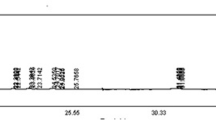Abstract
The basal diet (C), with 0.20% medicinal herbs (M) and 0.30% Bacillus (BM1), with 0.10% medicinal herbs and 0.15% Bacillus (BM2), and with 0.30% Bacillus (B), was used to feed white shrimps (Litopenaeus vannamei) (1.91 ± 0.03 g) in order to assess survival, growth, body composition, and digestive enzyme activity. At the end of the feeding trial, survival ranged from 95.83 to 98.33% with no significant difference (P > 0.05) among all groups. Growth measured as weight gain was significantly (P < 0.05) higher in shrimp fed with BM2, BM1, and M compared to that of C. However, no significant differences were found among B, BM1, and M. In the case of specific growth rate, the shrimp fed with BM1 and BM2 exhibited significantly (P < 0.05) higher values than that of C. The contents of body moisture, crude protein, and ash seemed to be unaffected by the feed supplements, though lipid content was found to be significantly (P < 0.05) different among the treatments. The shrimp fed with BM1 and BM2 had the lowest and highest lipid contents, respectively. The digestive enzyme activity assessed using shrimp hepatopancreas revealed that the activities of amylase and protease in shrimp fed with BM2 were significantly (P < 0.05) higher than those of C at the end of the 2nd and 6th weeks. However, better performance of the specific amylase activity was shown by the shrimp fed with B at the end of the 8th week.

Similar content being viewed by others
References
Akiyama DM, Coelho SR, Lawrence AL, Robison EH (1989) Apparent digestibility of feedstuffs by the marine shrimp Penaeus vannamei Boone. Nippon Suisan Gakkai Shi 55:91–98
Anson ML (1938) The estimation of pepsin, trypsin, papain and cathepsin with hemoglobin. J Gen Physiol 22:79–89. doi:10.1085/jgp.22.1.79
AOAC (Association of Official Analytical Chemists) (1995) Official methods of analysis. AOAC, Arlington, Va
Bernfeld P (1955) Amylase. In: Colowick SP, Kaplan NO (eds) Methods in enzymology. Academic Press, New York, pp 149–158
Bradford M (1976) A rapid and sensitive method for the quantitation of microgram quantities of protein utilizing the principle of protein-dye binding. Anal Biochem 72:248–254. doi:10.1016/0003-2697(76)90527-3
Chansue N, Ponpornpisit A, Endo M, Sakai M, Satoshi Y (2000) Improved immunity of tilapia Oreochromis niloticus by C-UP III, a herb medicine. Fish Pathol 35:89–90
Cross DE, Acamovic T, Deans SG, Mcdevitt RM (2002) The effects of dietary inclusion of herbs and their volatile oils on the performance of growing chickens. Br Poult Sci 43:S33–S35
Gatesoupe FJ (1999) The use of probiotics in aquaculture. Aquaculture 180:147–165. doi:10.1016/S0044-8486(99)00187-8
Immanuel G, Vincybai VC, Sivaram V, Palavesam A, Marian MP (2004) Effect of butanolic extracts from terrestrial herbs and seaweeds on the survival, growth and pathogen (Vibrio parahaemolyticus) load on shrimp Penaeus indicus juveniles. Aquaculture 236:53–65. doi:10.1016/j.aquaculture.2003.11.033
Jian JC, Wu ZH (2002) Effect of Chinese herbal medicine on nonspecific immunity of Jian common carp (Cyprinus carpio var. Jian). J Dalian Fish Univ 17:114–119
Karatas S, Dügenci N, Arda N, Candan A (2003) Some medicinal plants as immunostimulant for fish. J Ethnopharmacol 88:99–106. doi:10.1016/S0378-8741(03)00182-X
Lin HZ, Guo ZX, Yang YY, Zheng WH, Li ZJ (2004) Effect of dietary probiotics on apparent digestibility coefficients of nutrients of white shrimp Litopenaeus vannamei Boone. Aquacult Res 35:1441–1447. doi:10.1111/j.1365-2109.2004.01169.x
Lin HZ, Li ZJ, Chen YQ, Zheng WH, Yang K (2006) Effect of dietary medicinal herbs on apparent digestibility coefficients of nutrients for white shrimp Litopenaeus vannamei, Boone. Aquaculture 253:495–501. doi:10.1016/j.aquaculture.2004.11.048
Liu MJ, Lin L, Wang Z (2001) Metabolism of natural products by intestinal bacteria. Chin J Mod Appl Pharm 18:90–91
Liu HB, Zhang Y, Yang YH, Lu TY, Ye JD (2004) Effects of five Chinese herb medicines as additive in feed on the growth and intestineal microflora, in common carp (Cyprimu scarpio). J Dalian Fish Univ 19:16–20
Luo RX (1997) Induction of immunity substance in Penaeus chinensis by Chinese herbal medicine. Oceanol Limnol Sin 28:573–578
Moriarty DJW (1996) Microbial biotechnology: a key ingredient for sustainable aquaculture. Infofish Int 4:29–33
Moriarty DJW (1998) Control of luminous Vibrio species in penaeid aquaculture ponds. Aquaculture 164:351–358. doi:10.1016/S0044-8486(98)00199-9
Rengpipat S, Phianphak W, Piyatiratitivorakul S, Menasveta P (1998a) Effects of a probiotic bacterium on black tiger shrimp Penaeus monodon survival and growth. Aquaculture 167:301–313. doi:10.1016/S0044-8486(98)00305-6
Rengpipat S, Rukpratanporn S, Piyatiratitivorakul S, Menasveta P (1998b) Probiotics in aquaculture: a case study of probiotics for larvae of the black tiger shrimp (Penaeus monodon). In: Flegel TW (ed) Advances in shrimp biotechnology. National Center for Genetic Engineering and Biotechnology, Bangkok
Rengpipat S, Rukpratanporn S, Piyatiratitivorakul S, Menasaveta P (2000) Immunity enhancement on black tiger shrimp (Penaeus monodon) by a probiont bacterium (Bacillus S11). Aquaculture 191:271–288. doi:10.1016/S0044-8486(00)00440-3
Saeed ZN, Mehran HR, Ghobad AT, Donald LL, Ali-Reza M, Mehdi S (2006) The effect of Bacillus spp. bacteria used as probiotics on digestive enzyme activity, survival and growth in the Indian white shrimp Fenneropenaeus indicus. Aquaculture 252:516–524. doi:10.1016/j.aquaculture.2005.07.021
Acknowledgments
The authors are grateful and indebted to Prof. Mai KS and Ai QH for their kind advice and assistance. This study was supported by funds from National Key Technologies R&D Programme (Grant no. 2004BA526B0202, 2006BAK02A22) and Fishery prosper Science and Technology Project of Guangdong Province of China (Grant no. B200201A01).
Author information
Authors and Affiliations
Corresponding author
Rights and permissions
About this article
Cite this article
Yu, MC., Li, ZJ., Lin, HZ. et al. Effects of dietary medicinal herbs and Bacillus on survival, growth, body composition, and digestive enzyme activity of the white shrimp Litopenaeus vannamei . Aquacult Int 17, 377–384 (2009). https://doi.org/10.1007/s10499-008-9209-3
Received:
Accepted:
Published:
Issue Date:
DOI: https://doi.org/10.1007/s10499-008-9209-3




